


Abstract
The premium peanut oil can be determined as High-Oleic peanut oil made possible in India with the introduction of Girnar-4 and Girnar-5 peanut varieties. In which the fatty acid profile of Girnar-4 grown at five locations indicated the oleic acid content to be in the range of 79.2 to 80.6% and that of Girnar-5 in the range of 78.9 to 80.7%. The value of O/L ratio of these varieties is as high as ~17. These varieties have been recommended for cultivation in the Rajasthan, Gujarat, Andhra Pradesh, Karnataka and Tamil Nadu in kharif season.
Introduction
The fatty acid composition of common groundnut oil typically comprises oleic and linoleic acids as the major fractions with mean values of ~45 and ~32 per cent, respectively. Palmitic acid, a saturated fatty acid monounsaturated (SFA), is the third most abundant fatty acid (~17 per cent) of groundnut oil. Oleic acid is a fatty acid (MUFA) while linoleic acid is a polyunsaturated fatty acid (PUFA). Oleic acid believed to help lower the 'bad' cholesterol, raise 'good' cholesterol, and promote ‘good cardio vascular health'
The high-oleic groundnuts having 70 to 80 per cent oleic acid may have O/L ratio value greater 15. The high-oleic is a desirable trait for groundnut industry because it confers high oxidative stability to groundnut products. The ease of formation of fatty acid radicals increases with increasing with unsaturations and PUFAs are more susceptible to oxidation than MUFAs. Rancidity is the process by which the double bonds of unsaturated fatty acids in the oil combine with oxygen to form oxidation products with accompanying off-flavours and smells. The oxidation of oil is the main cause of rancidity. Oleic acid is 10-40 times less susceptible to oxidation than Linoleic acid. Therefore, the higher oleic acid content affords a longer shelf-life to groundnut products like roasted or fried whole groundnuts; groundnut flour; and the edible products prepared using groundnut oil.
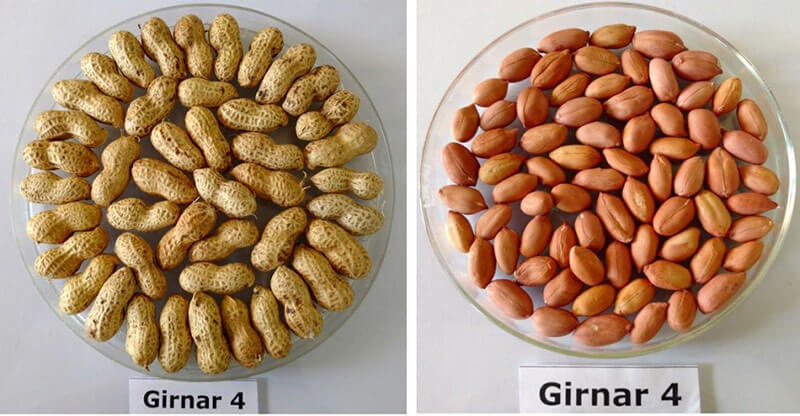
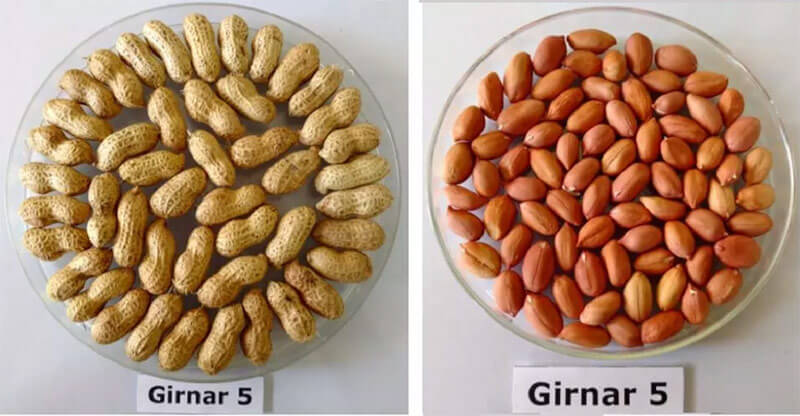
Development of Girnar varieties
 In a collaborative effort by the lCAR-Directorate of Groundnut Research (ICAR-DGR), International crops Research institute for semi-Arid Tropics (ICRlSAT), and state Agricultural Universities, several high oleic groundnut lines were developed under a project supported by the Department of Agriculture, Cooperation and Farmers Welfare (Government of India). These lines were tested at multi locations through the network of the All India Coordinated Research Project on Groundnuts (AlCRPG) for their yield performance, and the stability of the oleic acid content. Of these, lCAR-DGR has released two high-oleic Virginia bunch genotypes viz., 'lCGV 15083' by the name 'Girnar-4' and 'ICGV 15090' by the name'Girnar-5'.
In a collaborative effort by the lCAR-Directorate of Groundnut Research (ICAR-DGR), International crops Research institute for semi-Arid Tropics (ICRlSAT), and state Agricultural Universities, several high oleic groundnut lines were developed under a project supported by the Department of Agriculture, Cooperation and Farmers Welfare (Government of India). These lines were tested at multi locations through the network of the All India Coordinated Research Project on Groundnuts (AlCRPG) for their yield performance, and the stability of the oleic acid content. Of these, lCAR-DGR has released two high-oleic Virginia bunch genotypes viz., 'lCGV 15083' by the name 'Girnar-4' and 'ICGV 15090' by the name'Girnar-5'.
O/L ratio with respect to geography
The value of O/L ratio of these varieties is as high as ~17. These varieties have been recommended for cultivation in the Rajasthan, Gujarat, Andhra Pradesh, Karnataka and Tamil Nadu in kharif season. The varieties mature in 110-115 days. The average 100-seed mass of Girnar-4 is 43g (~65.9 count per ounce) and that of Girnar-5 is 41g (~69.1 count per ounce). 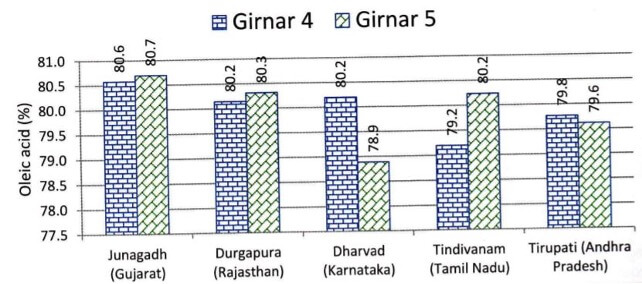
Image: Oleic acid content (%) of oil of Girnar-4 and Girnar-5 groundnut varieties grown at five locations (average values of 2017 and 2018)
Pod yield ratio with respect to geography
Across the five locations, the yield of Girnar-4 was in the range of 2321 to 4462 kg/ha and that of Girnar-5 in the range 2309 to 4222kg/ha. The fatty acid profile of Girnar-4 grown at five locations indicated the oleic acid content to be in the range of 79.2 to 80.6% and that of Girnar-5 in the range of 78.9 to 80.7%. 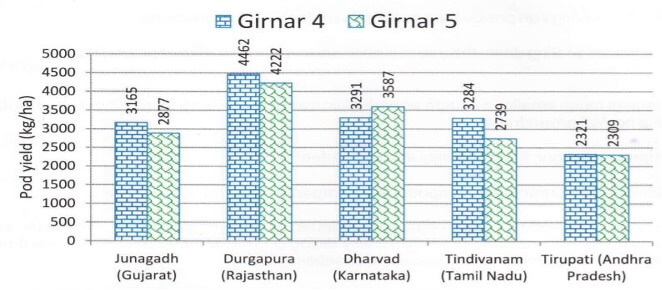
Image: Pod yield of Girnar-4 and Girnar-S groundnut varieties in five locations (average values of 2017 and 2018)
Economic benefits of Girnar-4 & Girnar-5
• Allows scaling down expenditure on "barrier packaging" which protects the foods from oxygen, water, water vapours, aromas, light, grease, oils etc.
• Permits savings on pre-coating costs in manufacture of confections.
• Facilitates scaling down the use of stabilizers in manufacturing of peanut butter
• Causes much smaller wastage as high oleic trait affords 10-15 times longer shelf life than that of the normal groundnuts
• Improves flavour, flavor stability and mouth-feel
• Slows down formation of compounds that impart “off” flavours
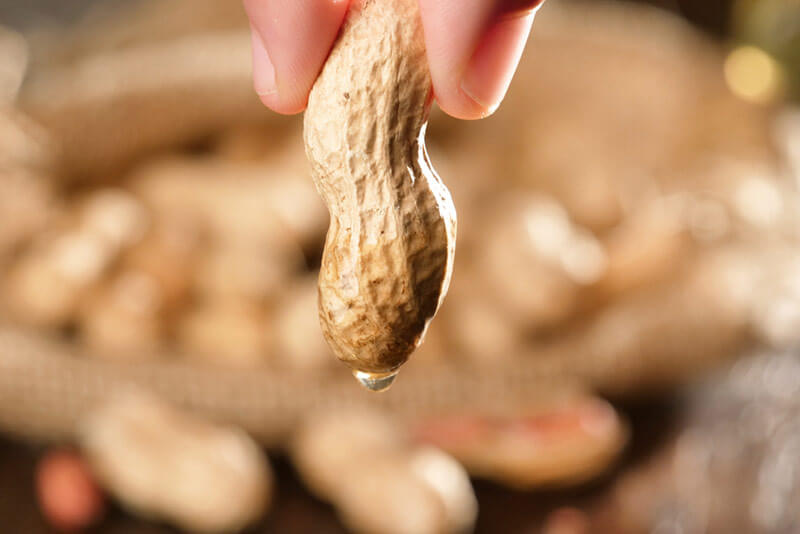
Conclusion
The important high-oleic groundnuts from other countries and re-exporting the same after processing in India would not be economically as competitive as processing the locally produced high-oleic groundnuts for export or even supplying to the local consumers. Further, the local availability of high oleic groundnut oil will open a new market niche of heath oil for the domestic consumers.
Key words
Peanut oil, Quality, Girnar-4, Girnar-5, Premium peanut oil
Reference
Radhakrishnan T, SK Bera, JB Misra, ICAR-Directorate of Groundnut Research, Girnar-4 and Girnar-5: the First Ever Indigenous High-Oleic Groundnut Varieties, December 2020 DOI: 10.13140/RG.2.2.27314.43200
Key Takeaways
• Allows scaling down expenditure on "barrier packaging".
• Permits savings on pre-coating costs, Improves flavour, flavor stability and mouth-feel.
• Facilitates scaling down the use of stabilizers in manufacturing of peanut butter.
